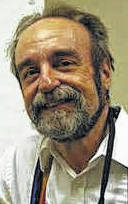
On Monday, April 8, the moon will pass between Earth and the sun, and central Ohioans will witness a total solar eclipse.
Important! Don’t look at the sun without ISO-certified eclipse glasses or a similarly approved hand-held solar filter.
Don’t look at the sun in binoculars or a telescope unless it has an approved front-end solar filter.
Inspect your solar filter or eclipse glasses against a strong light before every use. Look for pinholes, creases or other damage.
If you don’t have eclipse glasses or an approved filter, use indirect methods, like pinhole projection, to observe the partial phases. See https://www.exploratorium.edu/eclipse/how-to-view-eclipse for indirect methods.
The notable exception occurs during the brief period of totality. When the sun disappears entirely in your eclipse glasses, take them off. During that period, which can last a few seconds or up to four minutes, the sun’s glorious atmosphere, called its corona, will be visible.
The corona is only about as bright as the full moon and is extraordinarily beautiful. When the total phase ends, put the glasses back on.
The following times and percentages may vary depending on your observing location.
Assuming the sky is clear, the Delaware eclipse experience will begin at 1:55 p.m. as the moon takes its first nibble out of the solar cookie. Eclipse glasses on.
As the moon moves in front of the sun, the nibble slowly becomes a bite, progressively increasing in size until 3:11 p.m. The moon has now blocked the sun completely, and the total eclipse has begun. Eclipse glasses off.
In Delaware, the total phase lasts 2 minutes and 37 seconds. At 3:14 p.m., a thin crescent sun will again be visible. Eclipse glasses on.
The bite gets progressively smaller until 4:27 p.m. The entire disk of the sun is again visible. The eclipse is over.
For the timings at other locations, check out https://www.timeanddate.com/eclipse/map/2024-april-8.
The sun is 400 times the moon’s diameter. But the sun is also 400 times farther away. Consequently, the two objects look about the same size, about half an angular degree. (Half a degree is about the width of your little fingernail at arm’s length.)
The April 8 eclipse is total along a 120-mile path as the moon’s 120-mile-wide shadow sweeps across North America at about 1,000 mph. The shadow will travel from south of the Baja Peninsula in the Pacific Ocean through parts of central Mexico, Texas, Arkansas, Missouri, Illinois, Indiana, northwest and central Ohio, New York, Maine, eastern Canada, and into the Atlantic Ocean.
If you observe outside the path of totality, you will experience only the partial phases. As you travel away from the path, the moon’s bite of the sun progressively decreases.
If you are lucky enough to observe along the shadow’s center line, the totality period can last up to 4.5 minutes.
Travel north to Marion, for example, and you’ll get three minutes and 27 seconds of totality. Lorain will get a 3-minute, 54-second totality.
Travel west toward the shadow path’s centerline near Wapakoneta, and you’ll get a nearly 4-minute totality.
Of course, a cloudy sky will spoil the view. It will get dark as night during the totality, but the experience is a poor substitute for the glorious corona.
If the sky is clear and you can do so, consider traveling toward the center line. Move toward a clear sky if it’s cloudy at your original observing location.
If I may borrow an analogy from essayist Annie Dillard, the difference between a partial eclipse and a total eclipse is the difference between flying in an airplane and jumping out of one.
Eclipse chasing, as astronerds call it, is often terribly inconvenient. A two-hour drive to the centerline will almost certainly be followed by a daylong crawl home.
Seek totality. You have a ticket to the Super Bowl. Don’t sit in the parking lot listening to it on the radio because you would rather not face the crowd in the stadium.
Seeing a totality and the sun’s magnificent corona can be a life-changing, powerfully emotional experience, at least it was for me when I saw a seven-minute totality off the coast of Baja in 1991.
Please join me and thousands of central Ohioans as we stand awestruck in the shadow of the moon.
Tom Burns is the former director of the Perkins Observatory in Delaware.

